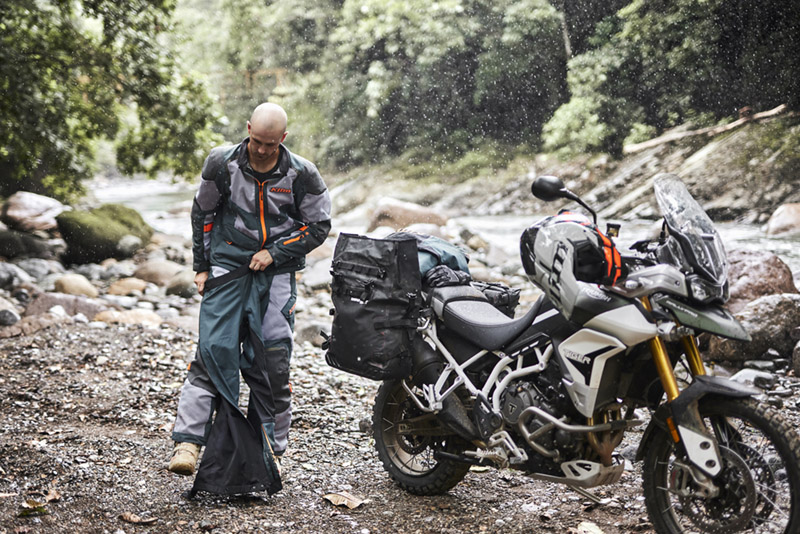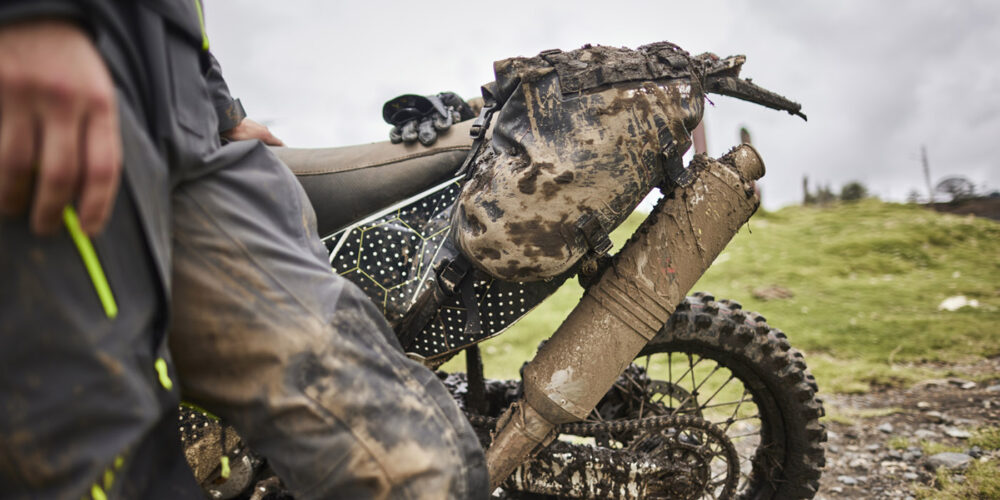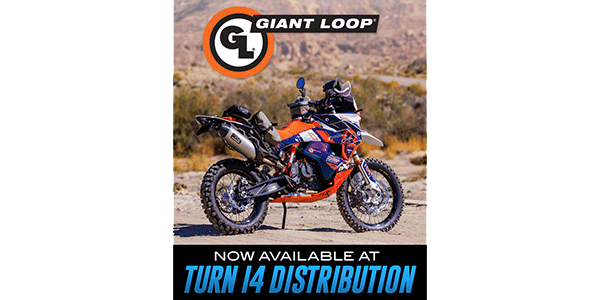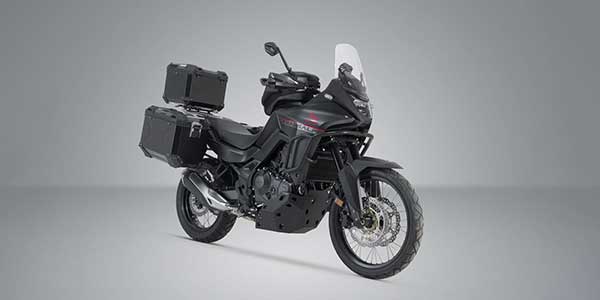Brand new adventure bike? Check.
Waterproof luggage? Check.
Next stop, the bottom of the Marianas Trench? … Not so fast.
What Is Waterproof?
In the world of motorcycle luggage, the expectation is that the contents of the luggage stay dry. But the real question is, under what exact circumstances?
Manufacturers set their standards and perform their testing in no uniform way. What tends to be agreed upon is that the luggage should keep the contents dry in a rainstorm but not necessarily if the luggage is submerged under water. The more stringent test that some manufacturers use — but not all pass — is the 100 mph-in-a-rainstorm test with a crosswind. This means that with either the bike stationery and rain falling vertically on the luggage or the bike riding at 100 mph in an intense rainstorm and with crosswind, water should not come in.
Some manufacturers go a step further and test how long a piece of luggage can keep water out in case a rider were to drop the bike while crossing a river.
How to Achieve Waterproofing
To claim a motorcycle luggage piece is waterproof, several tactics are used across the industry.
The most basic approach is a water-resistant cover put over the non-water-resistant luggage piece. To help visualize this, imagine a tank bag with your grandmother’s shower cap put on top of the tank bag. The issue with this basic approach is that when riding at speed in a rainstorm, water ends up coming up under the water-resistant cover, and the bag gets soaked and the contents get wet. Additionally, you have the cover flapping in the wind.
The next iteration of achieving waterproofness is via a generic water-resistant dry bag that goes inside the luggage piece. To help visualize this, imagine a pannier or saddle bag with a big kitchen Ziploc bag inside. This is effective but has its advantages and disadvantages. The advantages include that it’s inexpensive, keeps your contents dry and allows the exterior of the bag a lot of design freedom to make an appealing and tough luggage product. The disadvantages are quite a few.
In cases of larger and more complex luggage pieces, getting this inner dry bag inside the exterior bag can be tricky and cumbersome. Being a two-piece system means it’s heavy and becomes even more so in a rainstorm as the exterior bag soaks up water. After a few wet/dry cycles, add in some dirt and road grime, and now your exterior bag is not looking too pretty and has its own distinct smell that will keep little kids and animals away from your bike.

Now imagine you have been riding for a few hours off-road in the rain. You arrive to your destination, be it either a hotel or your campsite. You go take out this inner dry bag, and the inside of your luggage/exterior of your dry bag is wet and full of dirt and grit. You need to clean the dry bag off before you bring it inside the hotel or tent. While it is convenient to be able to leave the exterior bag on the bike and take with you the inner dry bag, it’s not as convenient in real world applications if the inner bag is filthy.
The third and most elegant solution is to make the luggage waterproof from the start. No smoke and mirrors, no covers, no generic dry bags — just waterproof bliss. It’s easier said than done and has its own advantages and disadvantages.
One disadvantage is that it’s not cheap if it’s done right. From a design perspective, it takes a lot of effort to make a single-piece functional waterproof luggage product that works well. Once you get past the design, the many advantages kick in. It’s lightweight and stays lightweight since it does not absorb water. It’s easy to clean and stays smell-neutral over time. Some would argue that a one-piece system means you will have to unmount your luggage from your bike when you arrive at your hotel or campsite; while this is true, the problem is easily solved by adding an optional inner bag liner. Because the luggage itself is waterproof and keeps the interior dry and clean, these inner bags can be lightweight and simple. They can be made of a material that easily lets it slide in and out of the bag while separating clean and dry contents from wet, dirty or smelly contents.
Components of a Waterproof Luggage System
Zippers
This topic is very complex, and even if you took a week-long class at YKK, you still would not be considered an expert in zippers. For the topic at hand, what is safe to say is that there are regular zippers, water-resistant zippers and then actually waterproof zippers.
Actual waterproof zippers are expensive and cumbersome to use, hence rarely seen. These types of zippers have their place in the moto luggage space but are usually reserved for the expensive pieces that have flat and simple openings or openings that have a large and gentle curvature, like that of a backpack. These types of zippers usually require periodic lubrication and cleaning (tip: old toothbrushes work well) to keep them operating smoothly. Waterproof zippers are stiff and require considerably more force to zip and unzip than other zippers.
Water-resistant zippers are the most common zipper seen and used. Most will call these zippers waterproof, but don’t be fooled: They are not. Because they are not waterproof alone, they usually are paired with secondary components, when used correctly. The most common form of this is with a water dam or water channel that redirects any water or moisture that gets past the zipper. For instance, in the case of a tank bag, a water-resistant zipper has a water diverter behind it. The bottom and top of the tank bag opening overlap so that if water does get past the zipper, it hits the water diverter/dam and gravity pulls the water down the drain. Water does not make it up and over the diverter/dam, and the contents stay dry.
Regular zippers are just that. They use materials that absorb water and, with little spray/force/flow, the water passes right through them. These are seen on low-cost, generic luggage that no one would argue is waterproof or water-resistant.
Roll Tops
While staying on the topic of sealing an opening, the next common component is the roll top opening. This is straightforward. There is extra material around the opening of the bag that is rolled onto itself to form a seal. The idea here is that if you roll the material onto itself enough times, it becomes hard for water to get in. With enough rolls, you can even submerge a luggage piece underwater and water won’t get in. Using a stiffener along the edge of the rolltop makes it easier to neatly roll the material.
Materials
Next is the material itself from which the bag is made. The first is your generic polyester/nylon fabric, which is not waterproof but can be made very resistant to tears and abrasion.
Second is your generic dry bag material. There is a wide range of materials here; some are more resistant to abuse, and others don’t do well in the medium and long term when exposed to the sun’s ultraviolet (UV) rays.
The third and most expensive are the multilayer, bonded waterproof fabrics. These usually use a three-layer system, where the exterior is abrasion-, tear- and UV-resistant, and a middle layer that has a multi-directional fabric component that gives it structure. Lastly, an interior layer adds waterproofness and can be a bright/high contrast color so when you look into a bag, it’s not like staring into an intergalactic black hole.
Air Purge Valves
Some manufacturers include air purge valves for convenience. They do make it convenient until the seal stops sealing or the valve gets snagged on something, and now you have a hole in your ex-waterproof bag. Silicone work well to permanently seal an air purge valve that failed. In most cases, just compressing the bag and letting the air out before the final pull of the zipper or roll of the roll top will make you good to go.
Pass-through Ports
The last element worth discussing is pass-through ports. These are mostly added to tank bags to allow charging cables to pass from the inside of the waterproof bag to an exterior map/cell phone/tablet pocket. Pass-through ports are not waterproof when submerged. But, if they are designed right, they won’t let water in during a rainstorm due to the layers/flaps. The really well-designed ports significantly slow the ingress of water if a bike decides to take a dive into a river. These pass-through ports are a necessary evil in the digital, electricity-hungry world we live in.
At the end of the day, making a quality waterproof luggage product is not easy. The motorcycle industry is fortunate to have a wide range of manufacturers and products available to riders.
Andres Escobar is the founder and president of LGP Powersports, the powersport division of a 66-year-old automotive distribution company. Andres has an education in mechanical engineering and business administration while having gasoline running through his veins from decades of race car and motorcycle involvement.
LGP Powersports is a multinational group of companies with exclusive distribution in North, Central and South America of brands such as Swiss luggage manufacturer Enduristan, world-renowned technical motorcycle gear manufacturer KLIM, e-dirt bike manufacturer Talaria and European tire manufacturer Mitas.














